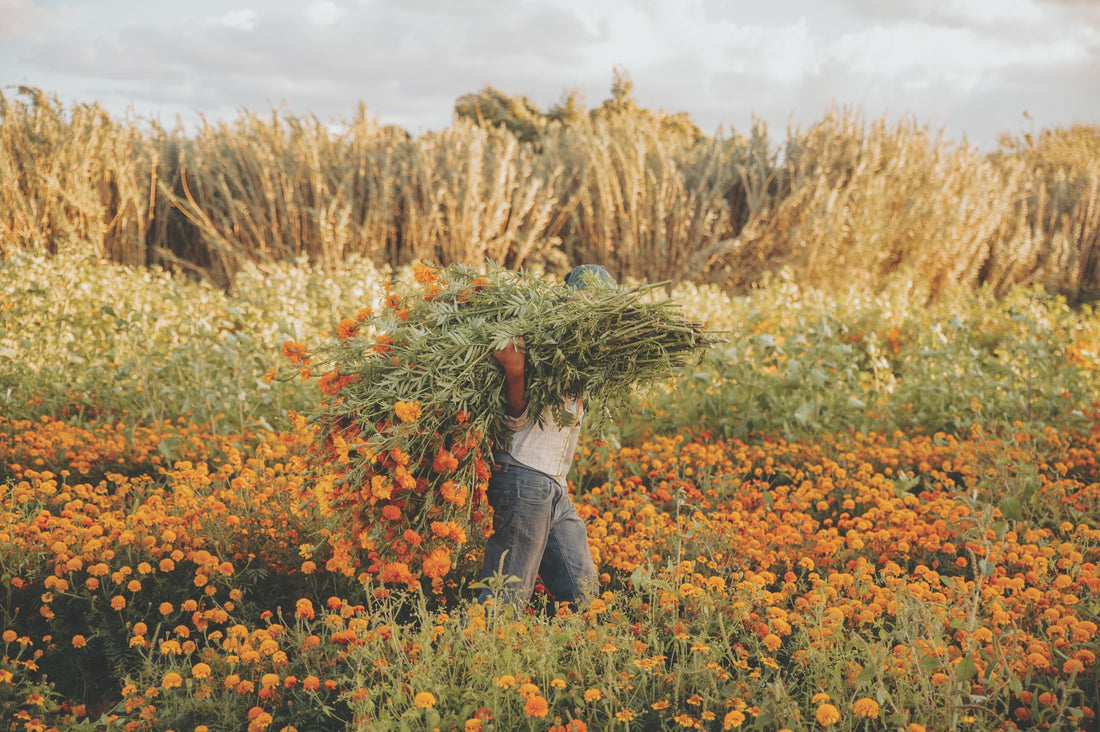
Going to Seed: Marigolds – when cultural celebrations and religious rituals meet textiles industry
In the world of flora, the marigold flower holds a special place. Admired for its vibrant hues, it’s not just a feast for the eyes but also a symbol steeped in culture and tradition across the globe. During November, across Mexico, fields radiate a sea of orange and yellow as the cempasuchil (marigold flower) blooms. Synonymous with the Dia de los Muertos, the Day of the Dead, this annual Mexican festival has become a global phenomenon. People venture from all corners of the world to experience Mexico in its brightest and most colourful celebration.
At its core, this festival honours the lives of loved ones who have died. The golden raise of the marigold is believed to guide the souls of the departed back to the world of the living during the celebration. While the primary days of celebration fall on the first two days of November, the ritual preparations begin a week prior. Traditionally, for those living in rural regions of Mexico, families come together and journey into the mountains to collect wild marigold flowers or visit their local village markets to purchase blooms from farmers. The marigold is used to decorate the ofrenda, an altar dedicated to deceased family members and displayed in their family’s home, local cemeteries beside graves, and in public.
spaces: parks, shop windows, and street displays.

Image above: Farmer in Oaxaca, Mexico, harvesting marigolds in preparation for Dia de los Muertos, 2023.
Latino folklore describes the marigold as “the flower of 20 petals,” and it has sacred geometry. The marigold is also valued for its medicinal properties: it is believed to aid digestion, grow and strengthen hair, and repel mosquitos. However, when the Dia de los Muertos festival ends, the abundant marigolds that adorn the streets are gathered and discarded or left to decay. Today, Oaxaca textile artists and designers are finding new ways to ensure the spirit of the marigold lives on beyond the short celebration.
Teotitlán del Valle in the central valley of Oaxaca is renowned for its textile production and centuries-old traditional dyeing practices. Here the yaabguu, marigold in Zapotec, the local language is cherished for its colour yelding quality. In the village of Xiguie’a, Dr. Samuel Bautista Lazo, along with his parents Mario Bautista Martínez and Leonar Lazo González, manage a Benizaa family-run rug company and farm – Dixza Rugs and Organic Farm – where they produce hand-dyed rugs woven with native criollo wool.

Reminiscing on the Dia de los Muertos celebrations during his childhood, Lazo says, “After the Day of the Dead, my mother would take the flowers off the altar and put them to rest on our flower bed and leave their seeds to germinate again.” This is a celebration of life and death and the cycles of life – rebirth and renewal. Working closely with local farmers who dedicate their land and lives to cultivate marigolds, Dixza Rugs has formed relationships that support their local community’s economy and agricultural practices to ensure that the growing and selling of marigolds are sustainable for the farmers. In the lead-up to the festival, the marigold is in high demand; however, following the celebration in November, when the sales of marigolds rapidly decline, Dixza Rugs purchases the remaining flowers from the harvest. They use the marigold as a dye plant to colour their criollo wool, which is handwoven into rugs. Their dyeing technique has remained unchanged for generations, and, as a zero-waste process, the entirety of the flower is used within their dye bath.
Want to read more of this article?
We are proud to be a subscriber-funded publication with members in 185 countries. We know our readership is passionate about textiles, so we invite you to help us preserve and promote the stories, memories, and histories that fabric holds. Your support allows us to publish our magazine, and also ‘what's on’ information, and subscription interviews, reviews, and long-read articles in our online blog.
ALREADY A SUBSCRIBER? CLICK HERE TO ACCESS CONTENT
OR...to continue reading….

*Magazine subscribers automatically get free access to all our online content. We send the access code by email with the publication of each issue. You will also find it on the envelope containing your magazine. Please note the access code changes every issue.*
